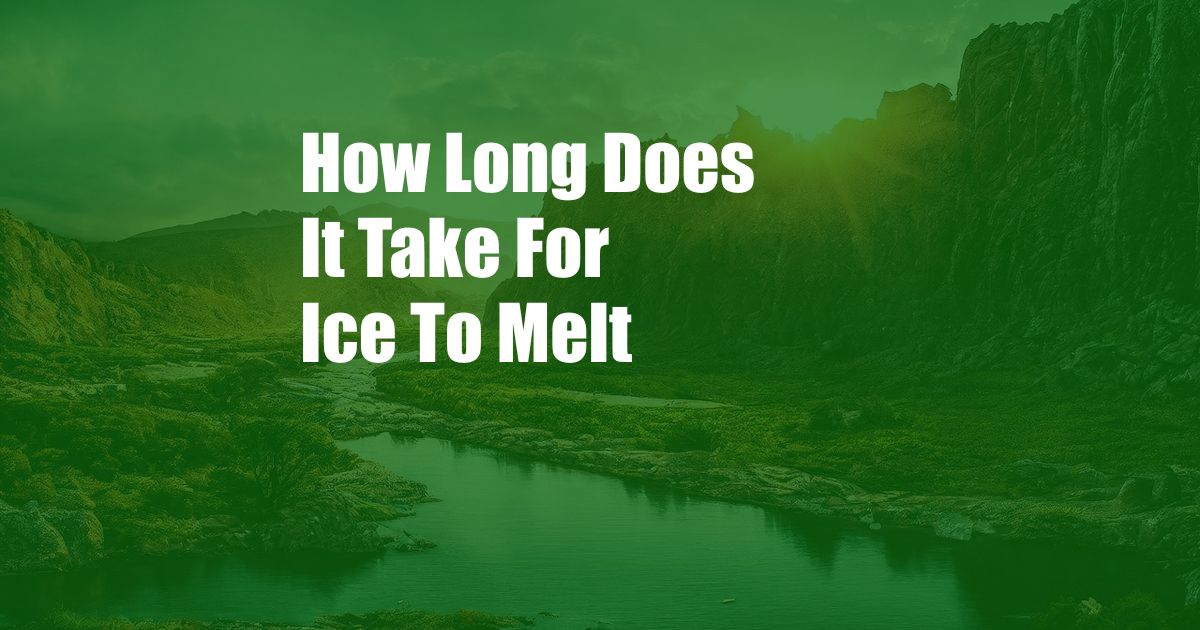
How Long Does It Take for Ice to Melt?
Summertime is in full swing, and it’s fun to see all the ice cream and popsicles that are around. Have you ever wondered how long it takes for ice to melt? As a child, I remember being very disappointed when some ice melted faster than I thought it would. That’s why I decided to dive into this topic and share my findings with you.
Which Factors Affect How Long It Takes for Ice to Melt?
Several factors can affect how long it takes for ice to melt, including:
- The temperature: The higher the temperature, the faster the ice will melt. This is because heat energy causes the water molecules in the ice to move faster and break away from the crystal structure.
- The surface area: The greater the surface area of the ice, the faster it will melt. This is because there is more surface area for heat to transfer into the ice.
- The shape: The shape of the ice can also affect how fast it melts. For example, a thin sheet of ice will melt faster than a large block of ice. This is because heat can transfer more easily through a thin sheet of ice.
- The presence of salt: Salt can speed up the melting process. This is because salt lowers the freezing point of water. When salt is added to ice, it causes the water molecules to break away from the crystal structure more easily.
How Long Does It Take for Ice to Melt at Room Temperature?
At room temperature (around 20°C or 68°F), it takes approximately one hour for one kilogram of ice to melt. However, the rate at which the ice will melt will vary depending on the factors mentioned above.
What are the Applications of Ice Melting?
The melting of ice has various applications, such as:
- Cooling: Ice is used to cool drinks, food, and other objects.
- Preservation: Ice is used to preserve food by slowing down the growth of bacteria.
- Medical: Ice is used to treat injuries and reduce inflammation.
- Industrial: Ice is used in various industrial processes, such as cooling machinery and manufacturing food.
Tips for Melting Ice Faster
If you need to melt ice quickly, there are a few things you can do:
- Add salt: As mentioned earlier, salt can speed up the melting process. Add a small amount of salt to the ice, and it will melt faster.
- Increase the surface area: Break the ice into smaller pieces to increase its surface area. This will allow heat to transfer more easily into the ice.
- Use warm water: Pour warm water over the ice to help it melt faster.
- Microwave: If you’re in a hurry, you can melt ice in the microwave. However, place the ice in a microwave-safe container and heat it in short bursts to prevent it from boiling over.
Frequently Asked Questions (FAQs) about Ice Melting
Q: Why does ice float on water?
A: Ice floats on water because it is less dense than water. When water freezes, the water molecules form a crystal structure that is less dense than the liquid water molecules. This is why ice cubes float on the surface of a glass of water.
Q: What is the freezing point of water?
A: The freezing point of water is 0°C or 32°F. This is the temperature at which water turns into ice.
Q: What is the boiling point of water?
A: The boiling point of water is 100°C or 212°F. This is the temperature at which water turns into steam.
Conclusion
The melting of ice is a common phenomenon that we often take for granted. However, there is more to ice melting than meets the eye. By understanding the factors that affect how long it takes for ice to melt, we can use this knowledge to our advantage in various applications.
Do you have any questions about ice melting? Please feel free to leave a comment below, and I’ll be happy to answer them.